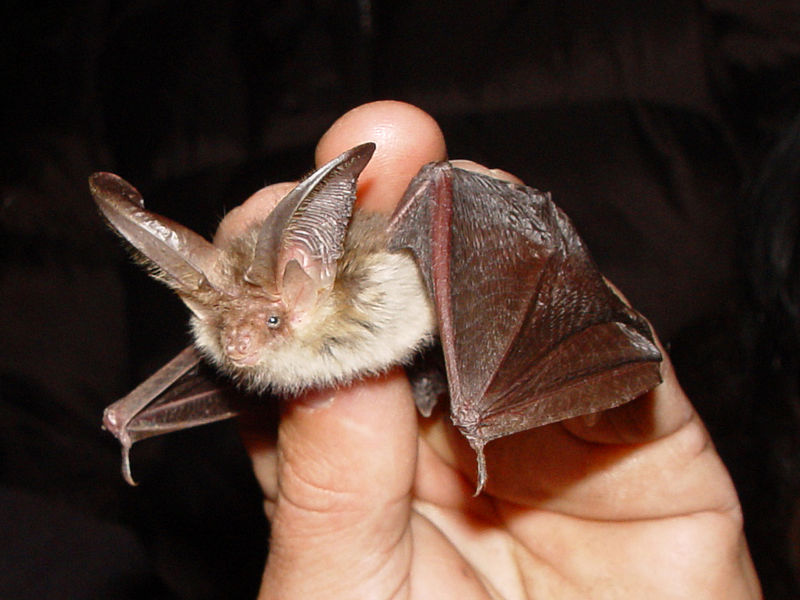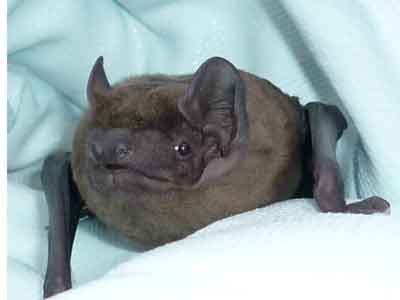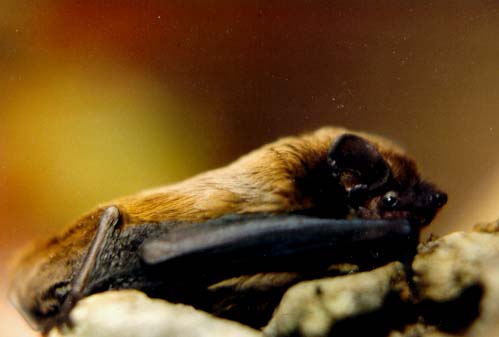The Millennium Green Trust has something of a reputation. They are always
lucky with the weather and on the evening of Saturday 18th
August, their luck continued! Seventeen villagers gathered at the churchyard
to hunt for bats. Ranging from the quite young to the well-retired, it was
clear that bats appeal to all ages.
Led by Staffordshire Ecological Services' Principal Ecologist, Dave Haslam,
the intrepid adventurers began with an introduction to bats. There are 17
species in the UK and Dave was hopeful that we would find four or five
species around the Millennium Green.
Dave started by checking that everyone knew how bats find their way in the
dark. Using echolocation – something like sonar – they send out sounds that
bounce back. Picking up the sound on its return enables the bat to tell how
far away something is, if it is moving, which way it is moving and what it
is 'made of' (insect or leaf for example). This requires extraordinarily
sensitive hearing and this enabled Dave to dispel some myths. Bats do not
live in Belfries! They do like churches because there are some nice holes
for them to squeeze into to roost or hibernate but the bells in the belfries
are just too loud! Also the amazing sensitivity of their hearing means that
they do not get caught in people's hair – they are too skilful for that!
Sometimes people think bats are quite big – but the
Pipistrelle
bat
(Pipistrellus pipistrellus)
is tiny. It weighs the
same as a two pence coin and its head and body are just one and a half
inches (38mm) long. Its wingspan, however is 9 inches (234 mm). This is why
bats look big when they are seen flying – they have much larger wingspans
than the length of their bodies. All bats have furry bodies of different
shades of brown, ranging from dark, almost black through to light buff,
almost white on their tummies! They have bright little eyes that are about
as sensitive as ours – so they can 'see' conventionally' as well as with
their echolocation.
The next job before setting off to explore was to find out how to use a bat
detector. Ranging in price from about £50 up to several thousand pounds,
everyone was keen to use the bat detectors to 'hear' the bats. In fact a few
people (usually young people) have hearing sensitive enough to hear the bats
as they call to each other, but the electronic wizardry of bat detectors
catches the sounds, lowers, and slows the sounds to make it audible to
enthusiastic bat hunters. Operating the bat detector involves twiddling a
couple of knobs to select the frequency for the target species of bat (each
species has its 'normal' range) and then turning up the volume.
Having mastered the technique, we set off around the church to see what was
about. Initially this involved a lot of standing around chatting while we
waited for the sun to set. Having nice weather had just one 'downside' – it
stayed light quite late and the bats don't come out until it is quite dark.
The 'upside' was that we were treated to some stunning skies – the reds,
pinks, violets, deep blues and purples were in some ways unreal – it was
said that if an artist painted those colours, people would not believe them!
Eventually it was dark enough and then the bat detectors started beeping and
clicking: Pipistrelles. These are
our most common bat but lovely to hear. There are three species of
Pipistrelle in the UK and two of them were flying around the church – The
Common Pipistrelle and the Soprano Pipistrelle. They look alike but as the
name suggests, the Soprano Pipistrelle (Pipistrellus pygmaeus) has a
higher-pitched call and it also has a 2 mm narrower wingspan (just over 1/16th
of an inch!). They tend to set up a flight path that they repeat several
times and this appeared to be making a circuit of the church, for no sooner
had we tuned in to them, than they disappeared only to reappear a short
while later. At the early stages of the evening there was still enough
evening light to catch a glimpse of the bats as they flew past but soon it
was too dark to see them and we moved on to the Millennium Green Pond.
The first problem we encountered brought to mind an old song: - “One man
went to mow, went to mow a meadow”! The local farmer had wisely decided to
make the most of the fine weather and at nine o'clock in the evening, was
mowing the meadow next to the pond making it impossible to hear the bat
detectors until the tractor disappeared to the other end of the field. We,
of course, were amused at the idea of him wondering what on earth a group
people with powerful torches standing around the pond were up to. If he
reads this he'll know now!
While we waited, John Bainbridge commented that bats were ugly little beasts
and was surprised to get a retort of “No they're not – they're lovely,
pretty, furry little things”. The photos below will
enable you to decide for yourself.
We
heard a hint of Pipistrelle and were delighted to be able to hear them
catching their prey. The echolocation sounds gets shorter and shorter as the
bat homes in on the insect and consequently eventually the sounds are so
close together that they sound like someone 'blowing a raspberry'!
We
also heard one or two other sounds that were too short to identify. However,
Dave had a very expensive bat detector that recorded the sounds and he would
be able to link to his computer to look at sonograms. These show the
distinctive sound patterns of each bat and provide clear identification.
Within a few days, Dave was able to confirm that there were three species of
bat around the pond – the two Pipistrelle species and the
Noctule
(Nyactalus
noctula) bat
which likes water. The Noctule has beautiful chestnut coloured fur and is
larger than the other species that we saw with a wingspan of 14 inches (350
mm). It is a fast flier as well – it can fly up to 30 miles an hour.
(Pipistrelles only make it to about 10mph).
Different species of bat like to emerge from their daytime roosts at
different times after dark, so after a while we returned to the churchyard
to see whether any other bats had emerged. We struck lucky arriving near the
porch as a series of much quieter clicks told us that a different kind of
bat was about. The torches revealed them going under a tile near the porch.
"Brown Long-eared Bat"
said
Dave. These bats have ears that are longer than their body – imagine
us having 4-foot long ears! These are so sensitive that the Long-eared bats
can not only hear flying insects, but also insects walking about on leaves.
Dave later confirmed that as well as the Pipistrelles and Brown Long-eared
Bat (Plecotus auritus), there were Noctule bats and
Leisler's (Nyactalus leisleri)
bats in the
churchyard. The latter are quite rare and it is nice to know that we are
lucky enough to have them in the village.
Eventually it was time to go home after an evening of learning about bats,
looking for bats, listening to bats, discussing bats and having a pleasant
stroll with friends around the churchyard and the pond.
Dave has promised that next year he will do a Moth Night which should prove
equally fascinating, so watch this website.
Staffordshire Ecological Services is the consultancy arm of the
Staffordshire Wildlife
Trust. As
with much wildlife, bats have their own 'conservation' group. The
Bat Conservation Trust
works to educate people about bats, including arranging bat walks, as well
supporting local bat groups and scientists, providing advice to developers
and 'lobbying' on behalf of bats.
(and now see the photos below of the Clifton Campville Millenium Green bat
species). . . . . .



